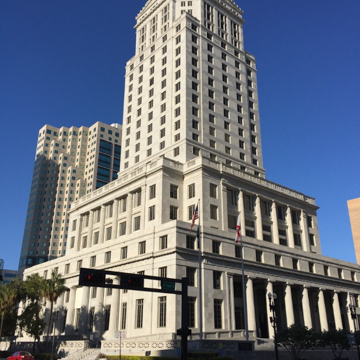The Dade County Courthouse was the most prominent civic structure in downtown Miami when it was built on West Flagler Street in the 1920s. The building represented an attempt to adapt Neoclassical architecture, which was already associated with civic government, to the emerging paradigm of the skyscraper. Atlanta architect Albert Anthony Ten Eyck Brown (working with Miami architect August Geiger) was commissioned to give physical form to the young city’s self-identification with the American tradition of democratic governance (as represented by the Greek Revival forms of the building’s base) and its aspirations toward modernity (as expressed through the soaring mass of the tower). Brown adapted the design of his unrealized project for the new city hall of Atlanta. The completed building was the tallest structure in Miami, and served as both the city hall and the county courthouse.
Judicial affairs had been carried out in a building along the Miami River, east of the old Miami Avenue Bridge, since 1899. Five years later this building was replaced by a courthouse that was expected to serve the community for about fifty years. Yet by 1925, the city’s rapid growth necessitated the construction of a larger facility, and the old courthouse was demolished to make way for the current building.
Construction began at the height of the 1920s building boom, and the building was dedicated in September 1928. Construction was delayed by the 1926 hurricane and by the discovery that the building’s foundations were inadequate for the site’s waterlogged soil conditions (a problem resolved by pouring new concrete foundations that occupy much of the building’s basement). The Fleischer Engineering and Construction Company served as general contractor.
Contemporary accounts claimed that the 335-foot-tall tower was visible from 100 miles at sea when lit at night by electric lights. The building’s steel structural frame is clad with Stone Mountain granite on the lower three stories, while terra-cotta panels—glazed to resemble granite—cover the rest of the twenty-seven-story structure and make up its Doric ornamental details. The courthouse’s square base occupies an entire city block and rises in two stages of three stories each. The tower rises from the center of the base, and its slender proportions are exaggerated by a slightly protruding center portion on each facade and by the gradual reduction in mass from setbacks at the eighteenth floor. A ziggurat-shaped cap crowns the courthouse in a possible reference to the Mausoleum at Halicarnassus.
Brown’s design for the Dade County Courthouse was one of numerous early-twentieth-century government buildings that utilized slender towers cloaked in historicist facades, including McKim, Mead and White’s Municipal Building (1914) in New York. The Dade County Courthouse shares the ziggurat roofline of the exactly contemporaneous Los Angeles City Hall (John Parkinson, John C. Austin, and Albert C. Martin Sr.), and has similar proportions (at least in the tower) to the slightly earlier Nebraska State Capitol by Bertram Goodhue. Another possible influence on Brown’s project is the U.S. Custom House in Boston, whose similarly austere Greek Revival base was built in 1837 by Ammi Burnham Young, and to which a tower was added in 1913–1915 by Peabody and Stearns.
In 1954, city hall functions relocated to the former Pan Am Seaplane Terminal, while the courthouse continued to house various county offices, courtrooms, record rooms, judicial chambers, law libraries, and jail cells. In 1961, the jail cells in the building were closed, and county offices were moved to the newly completed County Administration Building, leaving only judicial affairs within the structure.
In 1979, Milton C. Harry and Associates prepared a restoration report for the Courthouse, which recommended cleaning and repairing the terra-cotta cladding, replacing the windows with new ones that resembled the originals, installing a new roof, and renovating the building’s interiors. Since funds to renovate the building were, and still are, limited, restoration has been ongoing since 1981. The structure continues to suffer from water intrusion and termite infestation, and significant damage to the terra-cotta cladding has yet to be repaired. The county has recently undertaken another round of renovations to the courthouse, which was listed of the National Register of Historic Places in 1989.
References
Craig, Robert M. Atlanta Architecture: Art Deco to Modern Classic, 1929-1959. Gretna, LA: Pelican, 1995.
Eaton, Sarah E. “Dade County Courthouse.” Heritage Conservation Board Designation Report. Miami: City of Miami Planning Department, 1985.
Mazzei, Patricia. “With Little Time Left, Proponents for New Miami-Dade Courthouse Press Case.” Miami Herald, October 14, 2014.
Mcbrien, Judith P. “M1-18 Dade County Courthouse.” Pocket Guide to Miami Architecture. 1st ed. New York: W.W. Norton, 2012.

